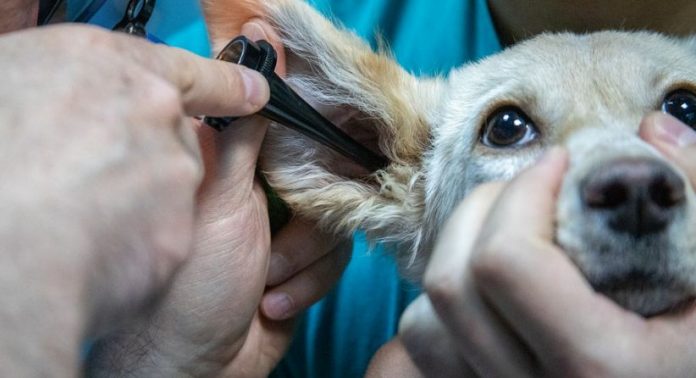Dog ear infections are also commonly called Otitis Externa. It is an infection of the outer ear canal. There are three parts to the ear; the outer, the middle, and the inner ear. Ninety percent of infections occur in the outer ear, the part of the ear that you can see.
Dogs are prone to ear infections because of the anatomy of their ears. They have a horizontal and a vertical component to them, so it is hard for anything in there to drain out, like water or debris.
Signs of an ear infection include excessive head shaking, yellow to brown exudate in the ears, or a yeast-like smell. Additional signs of ear infections include redness and swelling.
There are several causes of ear infections. The most common cause of ear infections is due to allergies. Some dogs are more prone to allergies than others; therefore they get more ear infections.
Another common cause is sporting dogs that swim. They get water inside their ears and provided their difficult anatomy, the water in the ears cannot drain out.
Therefore, this provides the perfect environment for bacteria and yeast to grow. It is recommended that if you let your dog play in the water you dry your dog’s ears thoroughly afterward.
If your dog does have an ear infection it is important to properly clean your dog’s ears before applying any medication.
To clean your dog’s ears, start by placing a few drops of an ear cleaner into the ear and massage the ear to help loosen any debris that is in the ear. Then use a cloth or cotton gauze to whip the dirt out.
After your dog’s ears are thoroughly clean, then you can apply your medication. Follow your veterinarian’s advice about how much medication to apply to the ear, usually a few drops.
The treatment your veterinarian will prescribe will vary depending on the cause of the ear infection. For yeast infections, they prescribe antifungals, for bacterial infections they will prescribe antibiotics.
Normally treatment is applied directly into the ears, but in severe cases, systemic treatment may be needed. This usually means have to give your dog pills orally.
In some dogs with severe ear problems, the veterinarian will usually clip the hair around the ear to help let more air into the ear. In extreme cases, your veterinarian may recommend surgery to reconstruct the ear canal to let it drain easier.
Breeds of dogs that are prone to ear infections include all breeds with large ears that flap over the ear canal and breeds of dogs that have a very small canal. By knowing what to look for, you can detect ear infections early.

